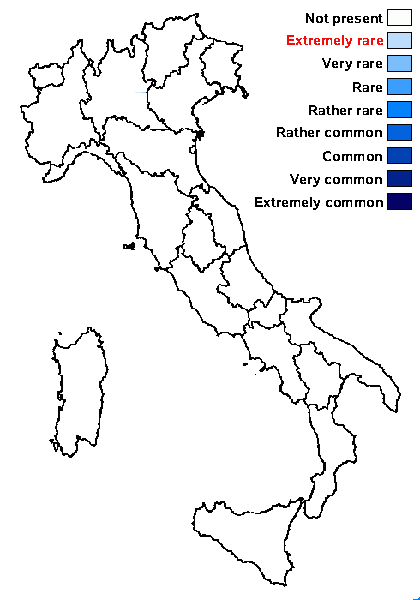Placocarpus melanophthalmosus Cl. Roux & Gueidan
Bull. Soc. linn. Provence, num. spéc. 14: 165, 2011
Synonyms:
Distribution:
Description: Thallus at first crustose, then squamulose, developing on the thalli of Rhizoplaca-species, the squamules of very variable sizes, 0.5-20 x 0.2-13 mm, 0.2-3 mm thick, brown but completely ash-grey-pruinose, subdivided into smaller, convex elements. Upper cortex overlain by a 2.5-15 μm thick epinecral layer (sometimes missing), composed of a t1–2(-4) layers of para- or almost scleroplectenchymatous cells in the upper part, and a colourless lower part; small crystals present in upper cortex and algal layer, visible under polarized light, insoluble in N, soluble in K; medulla thick, white, I + slowly (and often faintly I+ blue), with both large and small crystals. Perithecia without involucrellum, immersed in the squamules, up to 50 per squamule, appearing as black dots. Exciple pyriform, colourless throughout, except near the ostiole; hamathecium of short periphyses and pseudoparaphyses, interascal filaments absent; hymenial gel hemiamyloid, I+ red (I+ blue at very low concentrations of I), K/I+ blue. Asci 8-spored, clavate, bitunicate, with a thick tholus and an ocular chamber, I- except the outer coat which reacts I+ reddish, 61-72 x 18.5-23 μm. Ascospores 1-celled, hyaline, long-ellipsoid, (15.5)18.3-25(-27) x (6-)8-10(-12) μm, thinly halonate. Pycnidia immersed, appearing as black dots as the perithecia, pyriform to subglobose, plurilocular, Dermatocaarpon-type. Conidia simple, hyaline, short-bacilliform, straight, (3.5)4-5.5(-6) x 1-1.5 μm. Photobiont chlorococcoid. Spot tests: K-, C-, KC-, P-. Chemistry: without lichen substances.Note: a species first described from the Pyrenees as a parasite of Rhizoplaca melanophthalma, later also found in the French Alps (Alpes-de-Haute-Provence) as a parasite of Rhizoplaca chrysoleuca (Roux & Gueidan 2011, Roux & Bertrand 2016). To be looked for in the Italian Alps.
Growth form: Squamulose
Substrata: rocks
Photobiont: green algae other than Trentepohlia
Reproductive strategy: mainly sexual
Subcontinental: restricted to areas with a dry-subcontinental climate (e.g. dry Alpine valleys, parts of Mediterranean Italy)
paras Rhicoplaca-species

Predictive model
Growth form: Squamulose
Substrata: rocks
Photobiont: green algae other than Trentepohlia
Reproductive strategy: mainly sexual
Subcontinental: restricted to areas with a dry-subcontinental climate (e.g. dry Alpine valleys, parts of Mediterranean Italy)
paras Rhicoplaca-species

Predictive model

